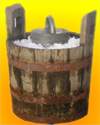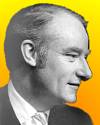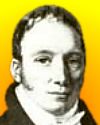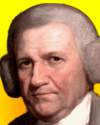
On 8 Jun 1786, the first American advertisement for commercially-made ice cream appeared in the New York Post Boy. Other details of the history of ice cream in American vary depending on the source, but books seems to agree on the fact of the date of the advertisement.
A Harper's Bazaar article on the Origin of Ice Cream (1899) provides some more information.

On 8 Jun 1955, Tim Berners-Lee was born, the English computer scientist who invented the World Wide Web when he thought “Suppose all the information stored on computers everywhere were linked?” Today's book pick is: Weaving the Web: The Original Design and Ultimate Destiny of the World Wide Web, by Tim Berners-Lee, in which he provides a lucid but impersonal memoir and conveys some of the vital history and intriguing philosophy concerning the Internet. He coined the acronyms URL, HTML and the “World Wide Web.” Who better to write on this subject?
It is available from Amazon, typically about New from $6.58. Used from $1.25. (As of earlier time of writing - subject to change.)
 | The major credit I think Jim and I deserve … is for selecting the right problem and sticking to it. It’s true that by blundering about we stumbled on gold, but the fact remains that we were looking for gold. Both of us had decided, quite independently of each other, that the central problem in molecular biology was the chemical structure of the gene. … We could not see what the answer was, but we considered it so important that we were determined to think about it long and hard, from any relevant point of view. |
 | I never know whether to be more surprised at Darwin himself for making so much of natural selection, or at his opponents for making so little of it. |
 | The web is more a social creation than a technical one. I designed it for a social effect—to help people work together—and not as a technical toy. The ultimate goal of the Web is to support and improve our weblike existence in the world. We clump into families, associations, and companies. We develop trust across the miles and distrust around the corner. |
| Before you look at today's web page, see if you can answer some of these questions about the events that happened on this day. Some of the names are very familiar. Others will likely stump you. Tickle your curiosity with these questions, then check your answers on today's web page. | |
| Births | |
 | Francis Crick was the British biophysicist, born 8 Jun 1916, who shared with James Watson, a Nobel Prize for Physiology or Medicine. It was awarded for their determination of the molecular structure of DNA - deoxyribonucleic acid. DNA is the chemical substance ultimately responsible for hereditary control of life functions. This accomplishment became a cornerstone of genetics and was widely regarded as one of the most important discoveries of 20th-century biology. In which decade was the Nobel Prize awarded to Crick and Watson? |
 | John Smeaton, born 8 Jun 1724, an English civil engineer and designer, is regarded as the father of civil engineering in Britain. In 1756-59 he built the third lighthouse at Plymouth, Devon, using dovetailed blocks of portland stone. He was the first to recognize what constitutes a hydraulic lime when he discovered the best mortar for underwater construction to be limestone with a high proportion of clay. Smeaton also constructed a canal, built bridges, completed Ramsgate harbour, improved the safety of the diving bell, and introduced cast-iron shafts and gearing for wind and water mills. What is the name of the Plymouth lighthouse (known in a song)? |
| Deaths | |
 | Joseph Paxton (1801-1865) was an English architect, designer of the architect of the building for the Great Exhibition of 1851 in London. The building was remarkable for its major use glass in its construction. Can you name this building? |
 | Walter Hunt died on 8 Jun 1859. He was the American inventor of what he called a “dress pin” on his patent. He sold the patent for $400 at a time of financial need. That was his sole benefit from the patent, although his pin was manufactured in vast numbers, and still is in the present day. By what name do we now know his invention? |
| Events | |
 | On 8 Jun of a certain year, creation of element 93, neptunium (symbol Np) was announced by Edwin M. McMillan and Philip H. Abelson working at the University of California at Berkeley. In what decade was neptunium made? |
 | On 8 Jun 1937, the world's largest flower bloomed in New York Botanical Garden; it was a giant Sumatran calla lily measuring 8.5 feet high and 4 feet in diameter. It has a distinctive fragrance. What does this fragrance imitate? |
Fast answers for the previous newsletter for June 7: a method of evaluating an infant shortly after birth to assess its well-being • chloroform • artificial intelligence • Joseph von Fraunhofer • solar power • the decade including the year 1870 • the decade including the year 1954.
 If you enjoy this newsletter, the website, or wish to offer encouragement or ideas, please send feedback by using your mail reader Reply button.
If you enjoy this newsletter, the website, or wish to offer encouragement or ideas, please send feedback by using your mail reader Reply button. Your click on a Facebook, StumbleUpon, or other social button on the site webpages is also a welcome sign of appreciation. Thank you for using them.
© This newsletter is copyright 2020 by todayinsci.com. Please respect the Webmaster's wishes and do not put copies online of the Newsletter — or any Today in Science History webpage. (If you already have done so, please remove them. Thank you.) Offline use in education is encouraged such as a printout on a bulletin board, or projected for classroom viewing. Online, descriptive links to our pages are welcomed, as these will provide a reader with the most recent revisions, additions and/or corrections of a webpage. For any other copyright questions, please contact the Webmaster by using your mail reader Reply button.
--
If you do not want to receive any more newsletters, Unsubscribe
To update your preferences and to unsubscribe visit this link
Executive Real Estate Business Class
-
"It was like a man with wings. It wasn't like anything you'd see on TV or in a monster movie." ...
About the publisher
Search This Blog
Blog Archive
-
▼
2021
(585)
-
▼
June
(64)
- On This Day for June 30 - Night of the Long Knives...
- Newsletter for Wednesday 30 June.
- On This Day for June 29 - London's Globe Theatre d...
- Newsletter for Tuesday 29 June.
- On This Day for June 28 - Assassination of Archduk...
- Newsletter for Monday 28 June.
- On This Day for June 27 - Yen made official moneta...
- Newsletter for Sunday 27 June.
- On This Day for June 26 - Opening of CN Tower, Bab...
- Newsletter for Saturday 26 June.
- On This Day for June 25 - Korean War begun, Antoni...
- Newsletter for Friday 25 June.
- On This Day for June 24 - Russia invaded by Napole...
- Newsletter for Thursday 24 June.
- On This Day for June 23 - Battle of Bannockburn, C...
- Newsletter for Wednesday 23 June.
- On This Day for June 22 - Mutiny against Henry Hud...
- Newsletter for Tuesday 22 June.
- On This Day for June 21 - Japanese forces defeated...
- Newsletter for Monday 21 June.
- On This Day for June 20 - Casket Letters found, Ho...
- Newsletter for Sunday 20 June.
- Tonight at 8/7c: Watch ‘Fight the Power’
- On This Day for June 19 - Rosenbergs executed for ...
- Newsletter for Saturday 19 June.
- On This Day for June 18 - War of 1812 begun, Sir P...
- Newsletter for Friday 18 June.
- On This Day for June 17 - Arrest of O.J. Simpson, ...
- Newsletter for Thursday 17 June.
- On This Day for June 16 - First woman in space, Jo...
- Newsletter for Wednesday 16 June.
- On This Day for June 15 - Magna Carta sealed by Ki...
- Newsletter for Tuesday 15 June.
- On This Day for June 14 - First prisoners at Ausch...
- Newsletter for Monday 14 June.
- On This Day for June 13 - Historic meeting between...
- Newsletter for Sunday 13 June.
- On This Day for June 12 - Election of Boris Yeltsi...
- Newsletter for Saturday 12 June.
- Listen Now! Blindspot: Tulsa Burning Podcast
- On This Day for June 11 - Oklahoma City bomber exe...
- Newsletter for Friday 11 June.
- On This Day for June 10 - First “witch” hanged in ...
- Newsletter for Thursday 10 June.
- On This Day for June 9 - Landslide reelection vict...
- Newsletter for Wednesday 9 June.
- On This Day for June 8 - Michelangelo's David inst...
- Newsletter for Tuesday 8 June.
- Action required: Update your HistoryExtra password
- On This Day for June 7 - Lateran Treaty ratified, ...
- Newsletter for Monday 7 June.
- On This Day for June 6 - Normandy Invasion begun, ...
- Newsletter for Sunday 6 June.
- On This Day for June 5 - Start of the Six-Day War,...
- Newsletter for Saturday 5 June.
- On This Day for June 4 - Dunkirk evacuation ended,...
- Newsletter for Friday 4 June.
- Tonight: ‘Alone’ Returns at 9:30/8:30c
- On This Day for June 3 - Pro-democracy protest in ...
- Newsletter for Thursday 3 June.
- On This Day for June 2 - Elizabeth II crowned quee...
- Newsletter for Wednesday 2 June.
- On This Day for June 1 - Debut of CNN, Morgan Free...
- Newsletter for Tuesday 1 June.
-
▼
June
(64)
-
Blogroll
-
About
HistoryFact










0 comments:
Post a Comment